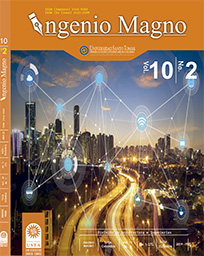Design and simulation of a waterjet material cutter for industrial use
Main Article Content
Abstract
Downloads
Article Details
DECLARATION OF ORGINIALITY OF SUBMITTED ARTICLE
With this document, I/We certify that the article submitted for possible publication in the institutional journal INGENIO MAGNO of the Research Center Alberto Magno CIIAM of the University Santo Tomás, Tunja campus, is entirely of my(our) own writing, and is a product of my(our) direct intellectual contribution to knowledge.
All data and references to completed publications are duly identified with their respective bibliographical entries and in the citations thus highlighted. If any adjustment or correction is needed, I(we) will contact the journal authorities in advance.
Due to that stated above, I(we) declare that the entirety of the submitted material is in accordance with applicable laws regarding intellectual and industrial property, and therefore, I(we) hold myself(ourselves) responsible for any complaint related to it.
If the submitted article is published, I(we) declare that I(we) fully relinquish publishing rights of the article to the University Santo Tomás, Tunja campus. As remuneration for this relinquishment of rights, I(we) declare my(our) agreement to receive two (2) copies of the edition of the journal in which my(our) article appears.
References
ALDAZABAL, J., MARTÍN-MEIZOSO, A., BANNISTER, A., CICERO GONZÁLEZ, S., & KLIMPEL, A. (2016). Propiedades mecánicas de las zonas afectadas por un corte láser, corte por plasma y oxicorte de una chapa de acero S460M de 15 mm de espesor.
ANCCA QUIROZ, E. M., & HUAMANI, R. H. (2017). Evaluación y determinación de la zona afectada por el calor en el acero
A36 por efecto del corte térmico entre los procesos oxiacetilénicos y plasma.
ARCOS VILLACÍS, P. A., & FIALLOS ORTIZ, J. D. (2010). Análisis comparativo de los procesos de corte por plasma, oxicorte y arc air aplicados a metales (Bachelor's thesis, QUITO/EPN/2010).
CHAVEZ J., & RODRIGUEZ, J. (2016). Diseño de una Boquilla para corte por chorro de agua de bajo costo. (Tesis UNAM, Ciudad universitaria, Ciudad de México) CRISTANCHO SANCHEZ, L. D. (2018). Efecto de la Redondez de la Arena Sobre el Desgaste Abrasivo A 3 Cuerpos Según la Norma Astm G65.
D., GARCÍA, T., CICERO, S., LACALLE, R., ÁLVAREZ, J. A., MARTÍN-MEIZOSO, A., & ALDAZÁBAL, J. (2015). Evaluación de las propiedades de tracción mediante ensayos Small Punch en la zona afectada por los cortes térmicos. In Anales de Mecánica de la Fractura (Vol. 32, pp. 593- 598).
FRANCO, A. F. V., & PAREDES, M. F. (2017). Corte mediante chorro de agua-abrasivo. Síntesis Tecnológica, (1), 36-38.
GAUERT, C. D. K., VAN DER WESTHUIZEN, W. A., CLAASEN, J. O., VILJOEN, S., & GROBLER, J. (2013). A progress report on ultra-high-pressure waterjet cutting underground: the future of narrow reef gold and PGE mining. Journal of the Southern African Institute of Mining and Metallurgy, 113(6), 0-0.
GROOVER, M. P. (1997). Fundamentos de manufactura moderna: materiales, procesos y sistemas. Pearson Educación.
INFANTE, S. A., DOMÍNGUEZ, A. B., SÁNCHEZ, M. C., LÓPEZ, R. L., MAÑAS, J. N., & HOLGUERAS, R. S. Herramientas de corte: desarrollo histórico y futuro.
KATZ, J. (1986). Desarrollo y crisis de la capacidad tecnológica Latinoamericana: el caso de la industria metalmecánica.
KRAR, S. F., CHECK, A. F., & SMID, P. (2002). Tecnología de las máquinas-herramienta. Alfaomega. LEVIN, I., & BRANDON, D. (1998). Metastable alumina polymorphs: crystal structures and transition sequences. Journal of the american ceramic society, 81(8), 1995-2012.
MARTÍN-MEIZOSO, A., ALDAZABAL, J., PEDREJÓN, J. L., & MORENO, S. (2014). Caracterización de la Zona Afectada por un Oxicorte. In Anales de Mecánica de la Fractura (Vol. 31, No. 04, p. 04).
MATAIX, C. (1982). Mecánica de fluidos y máquinas hidráulicas. Oxford University Press. MÉNDEZ, M. V. (1995). Tuberías a presión en los sistemas de abastecimiento de agua. Universidad Catolica Andres.
MEURLING, F., MELANDER, A., LINDER, J., LARSSON, M., "The influence of mechanical and laser cutting on the fatigue strengths of carbon and stainless sheet steels" Scand J Metall, vol. 30, no. 5, pp. 309-319.
MOSTOFA, M. G., KIL, K. Y., & HWAN, A. J. (2010). Computational fluid analysis of abrasive waterjet cutting head. Journal of mechanical science and technology, 24(1), 249-252.
OSTILLA, M. B., BALDO, P. J. R., & MARINO, J. M. Estudio de prefactibilidad para la construcción de una máquina de corte con agua para láminas de acero inoxidables de ½” de espesor.
PADILLA, E. D. (1999). Aplicaciones de los aceros inoxidables. Revista del Instituto de Investigación de la Facultad de Ingeniería Geológica, Minera, Metalurgica y Geográfica, 2(3), 11-22. PAGLIA, G. (2004). Determination of the structure of y-alumina using empirical and first principle calculations combined with supporting experiments (Doctoral dissertation, Curtin University).
PEMAN, T. P. G. (2015). Comportamiento en fatiga de componentes estructurales obtenidos mediante oxicorte, corte por plasma y corte por láser: comparativa y definición de curvas SN de diseño (Doctoral dissertation, Universidad de Cantabria).
RAMÓN, H., & JAVIER, F. (2014). Diseño y construcción de una máquina de control numérico por corte CO2 láser de 40 watts para acrílico de hasta 4 mm (Bachelor's thesis, Quito/UIDE/2014).
REAL SALADRIGAS, E. (2001). Aportaciones al estudio del comportamiento a flexión de estructuras de acero inoxidable. Universitat Politècnica de Catalunya. REYES-ORTIZ, Ó. J., & MILLÁN-MONTEJO, S. (2009). Influencia de la temperatura, la granulometría y el agua en la cohesión de mezclas asfálticas. Ingeniería y Universidad, 13(2), 309-324.
SHAMES, I. H., MONEVA, J. M., & CRUSELLS, S. P. (1967). La mecánica de los fluidos (Vol. 2). McGraw-Hill

